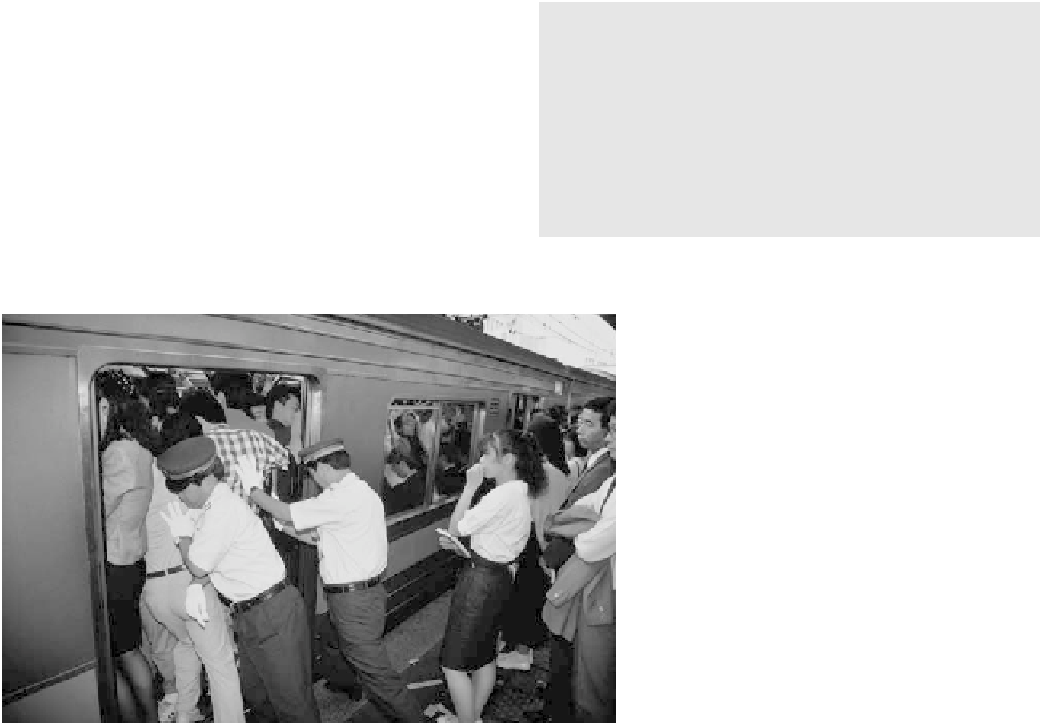Geography Reference
In-Depth Information
TOKYO: THE CITY WITH EVERYTHING
T Tokyo is famous for its crowding. Perhaps one of the most
enduring images of the city is of “commuters' hell” when
rush-hour trains and subways are jammed with home-
ward-bound passengers who, like sardines in a can, are
hardly able to move. In the morning the scene is repeated
as inbound trains are packed with commuters, with many
stations employing white-gloved “pushers” to cram in
still more passengers as the train car doors slide closed
(Figure 12-12). Many riders commute very long distances
and have to endure the crowding for two hours or more.
T Tokyo is linked to most other regions of the country
by
Shinkansen
or “Bullet T Trains” (Figure 12-13). These
high-speed trains fly along so fast that the scenery is only
a blur. The city ones are also jam-packed.
T Tokyo highways and side streets are also crowded
and standstill traffic jams are common. At times, even
pedestrian zones can be jammed with people complain-
ing about slow sidewalks and difficulties in walking even
short distances.
nation. Fourteen industries such as biotechnology , robot-
ics, software, and space were targeted for development in
tandem with research and development and other service
functions. These are to fuel additional industry in the
region.
Each technopolis centers on a “mother city” and is to
be linked by rapid transit to T Tokyo, Nagoya, or Osaka by no
longer than a one-day return trip. The new undersea tun-
nel to Hokkaido and bridge to Shikoku along with more
expressways and high-speed bullet trains are intended to
facilitate this goal. This evolving
T Techno-Archipelago
is
Japan' s landscape of the twenty-first century .
Eight technopoles within reach of T Tokyo have fared
well. The other 18 have not. Some have experienced a
decline in manufacturing employment and some have
actually lost population.
One problem is that major corporations have estab-
lished research laboratories close to their headquarters
rather than close to the production site. For example,
NEC research facilities are in Kawasaki near T Tokyo while
its product factory is in Kyushu. Consequently , there is
little technology transfer between incoming factories and
local industries. Thus far, the program has failed to
achieve its original objective to integrate techno-cities
with R&D, institutes of higher-learning and production
facilities.
In 2002, under the government' s “Big-Boned Policy ,”
another plan was put forward to better integrate such
facilities to enhance Japan' s economic competitiveness.
Some of these new integrated facilities, especially in the
area of medical technology , are meeting with success.
The Y akuzaNetwork
The Yakuza are traditional, organized crime syndi-
cates in Japan. They are arranged in 'families” with
a hierarchical structure from a number-one boss
through to the minions on the streets. The second-
in-command controls areas in individual cities. The
whole organization is structured according to
Figure 12-12
T Trains in T Tokyo are so crowded that people are
employed to push people into the cars.
©Paul
Chelsey/Stone/Getty Images, Inc.



















Search WWH ::

Custom Search